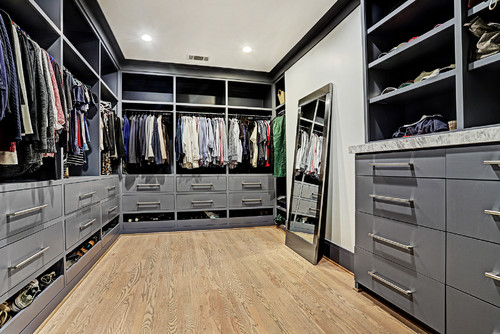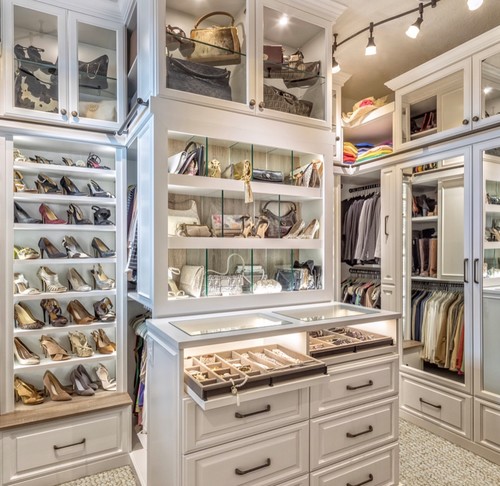Walk-in closet – a solution for the clutter.
If you are the fortunate owner of a room specifically designated for clothing, accessories, and shoes, you are aware that making the most of the space requires effort and planning. There is a direct correlation between space and clutter.
Please, read our post and do not forget to check our YouTube channel “Grig Stamate”:
https://www.youtube.com/@GrigStamate
You will find there, thousands of designing, furnishing, and decorating ideas for your home interior and outdoors.
Allow me to mention one of them:
Smart Design Ideas for Under-Stair Spaces (video)
Let’s continue our post but before that it is my privilege to present you with a beautiful video from the YouTube channel: “Kinoven – Robeson Design”.
Closet Organization | Declutter & Clean With Me | Organizing With Style 2023 (video)
Make optimal use of space.
Creating a clean, organized, and effective walk-in closet, organizing clothing, shoes, and accessories takes time. As a starting point, consider your actual storage requirements before moving on to more realistic alternatives. The following nine suggestions should help you acquire the ideal walk-in closet.
Divide the clothes into categories.
Although it may seem relatively obvious, many individuals forget the key benefit of grouping the clothing into categories, such as dresses, trousers, blouses, etc. Even though this crude categorization provides an overview, you can make an even better one by further categorizing the clothing. Here, you can, for instance, categorize by color or usage setting (daily, social, leisure, etc.). It will be much easier for you to find what you’re searching for and possibly come up with new methods to combine your wardrobe the better you are at organizing your walk-in closet into logical categories that suit your life and your items.
Another smart move is to allow your categories to change with the seasons. This way, you can quickly rearrange your categories a few times a year, putting thick knitwear at the back of the shelf in the summer, for example.

Photo by Ashwood Designs and Custom Homes – Discover closet design inspiration
Know the dimensions of the clothes.
Making the best use of the space on the shelves and hanger bars in your walk-in closet is a different, more prosaic, suggestion. When you optimize the area, it also provides a better overall picture.
You must first be mindful of the width of your clothing. You must determine the best way to arrange the clothing so that you don’t lose space at the bottom of the shelves because the depth of your cupboards and shelves will normally range from 35 cm (14 inches) to 60 cm (24 inches). The majority of shirts, blouses, jackets, and coats will comfortably fit in hanger sections that are 60 cm (24 inches) deep.
If the depth is smaller, there is a chance that your clothing will be overly tight and wrinkled as a result. Since many dresses don’t need as much depth as a coat, you might want to think about having two hangers, each with a different depth.
Here are some general guidelines to help you maximize the utilization of the area in your walk-in closet:
Folded sweaters and jumpers require a 23 cm (9 inches) deep shelf.
Coats may require a minimum height of 170 cm (67 inches).
Jeans and trousers need a vertical height of up to 127 cm (11 inches) (and about half that if they are folded in half and put on shelves or hung over a crossbar).
Shelves and hanger bars
How much of your clothing should be hung up and how much should be stored in drawers or shelves? Have you got more shirts than dresses? Do you have oversized coats and jackets for winter?
Whether you need the most high or low coat racks, or if you should prioritize the number of shelves, depends on your wardrobe composition.
Sweaters and blouses should be hung in the lower portions because they don’t require as much height when hanging on a hanger as dresses and long jackets, which must often be hung in the higher section with only one hanger bar. You might not require a bending bar if you choose to combine blouses and sweaters.

Photo by – Browse closet ideas
Count your dresses and coats if you have a lot of them so you can determine how much “high” hanging space you’ll need. If you don’t have a lot of this kind of clothes, you should definitely stick to the split parts with two hangers stacked on top of each other (or one hanger over a shelf), as the single hanger will take up unnecessary room underneath. It’s all about optimization, after all.
Unless there is capacity for a long coat, elevated portions with just one hanger bar are typically not necessary in a man’s wardrobe. Therefore, if the wardrobe is primarily comprised of T-shirts, jumpers, shirts, jeans, and suit pants, it is best to include numerous low sections or shelves.
Make room for a bench or a good stool.
When you need to button a shirt, tie your shoes, or adjust your socks, having a seat is convenient.
If you are fortunate enough to have a large walk-in closet, a free-standing bench or pouffe is the most adaptable option. Otherwise, you may want to think about buying a decent, sturdy stool.
Built-in seats are the ideal solution for placing beneath windows; consider adding a drawer for additional storage.
Shoes fill.
If there is room in your wardrobe for shoes, you must be exact and consider sparingly because shoes take up space and there are frequently more than you anticipate!
Women’s shoes normally have a width of 14–25 cm, whilst men’s shoes typically have a width of 17–25 cm. As a result, provide 18 to 30 cm of shelf space for each pair. Keep in mind that some of the shelves must be high enough to accommodate boots if you have them. While lengthier mid-calf or below-the-knee boots often measure 20 to 45 cm in height, ankle boots are typically at least 8 cm high.
Consider making room for an island.
The concept of placing a useful storage island in the midst of your walk-in closet is not as ridiculous as it might seem. Even though the island is somewhat small, it can serve as a deposit for items like jewelry while you change, and you’ll have enough on your storage island for several drawers that can hold most of your accessories. On either side of the island, you should have a minimum of 65 cm (ideally 90 cm) of walking space. Keep in mind that the drawers on the island will slide out more easily with greater space.
Don’t forget the mirror.
A mirror is necessary when selecting clothing. Whether it’s a regular day or a party. Think of a pull-out mirror as a necessary component of your closet that you can access whenever you need it. You can choose one or more sliding doors with mirror filling if you’d like a larger mirror; these come in silver, grey, and bronze. Mirrors will also help to enlarge and brighten your walk-in closet.
Good lighting.
Finding the clothes, you need is made simpler with the help of a lamp or spotlights in your walk-in closet. Additionally, you can put subtle LED lights inside the cabinets that switch on when the door is opened. The benefit of LED lighting is that the bulbs do not get hot in addition to being durable and energy efficient. This is helpful if you have to change clothing in a confined space.
Other related posts from our website:
https://howtobuildahouseblog.com/practical-tips-and-good-advice-for-walk-in-wardrobe/
https://howtobuildahouseblog.com/furniture-that-multiplies-the-square-footage-of-your-home/
Thank you so much for your attention.
Stay tuned. We will upload many other amazing posts to our website and videos onto our YouTube channel.
Thank you so much for your time and attention.
Best Regards
See you to another post,
Bye, Bye


